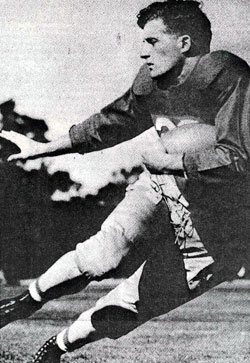 (Dec. 8, 1914 – Sep. 22, 1981) During his high school and college football days, Bobby Grayson became one of the West Coast’s greatest players, helping create a dynasty at both Jefferson High and then playing a key role in three teams that reached the Rose Bowl while at Stanford University.
(Dec. 8, 1914 – Sep. 22, 1981) During his high school and college football days, Bobby Grayson became one of the West Coast’s greatest players, helping create a dynasty at both Jefferson High and then playing a key role in three teams that reached the Rose Bowl while at Stanford University.
Born in Portland in 1914, Grayson reached the Jefferson varsity as a freshman in 1928 in the first season of legendary coach Eric Waldorf’s career at the school. As a quarterback, halfback and defensive back, Grayson helped the Democrats improve from 3-5-1 to 10-0-0 in four seasons. The 1931 team is famed for having outscored opponents 287-6, including 169-0 in seven games against Portland Interscholastic League teams. Grayson scored 117 points in those seven games.
Grayson also starred on the Jefferson track and field team, winning state titles in the 100-yard dash and 220-yard low hurdles in both 1931 and ’32.
Stanford’s legendary football coach Glenn “Pop” Warner then recruited Grayson to Stanford before leaving the following season for the position at Temple University. At Stanford, Grayson starred on both offense, as a quarterback and fullback, and defense as a safety.
The Indians, as they were then known, won the Pacific Coast Conference title in 1933, ’34 and ’35, and played in the Rose Bowl at the close of each of those seasons. They won the 1936 Rose Bowl, 7-0, over Columbia.
Grayson earned a spot on the All-America team as a quarterback in 1934, and fullback in 1935. In ’34, he set a school record with four interceptions during a game against Washington. In his three seasons on the varsity team, Grayson ran for 1,547 yards on 405 carries. He is regularly listed among the top five players in the history of Stanford football.
Following his senior season, the Pittsburgh Pirates (Steelers) of the fledgling National Football League selected Grayson with the third pick of the third round of the league’s first draft. But Grayson – as did first overall pick Jay Berwanger of Chicago University – chose to go into private business. He worked for companies in Oregon and Washington and served as the head of the U.S. Savings Bond Division for Oregon for eight years until retiring in 1980.
During World War II, Grayson served as commanding officer of the USS Loyalty, a minesweeper.
Grayson passed away in 1981 at age 66. He was inducted to the College Football Hall of Fame in 1955, and into the Oregon Sports Hall of Fame as part of the initial class in 1980.